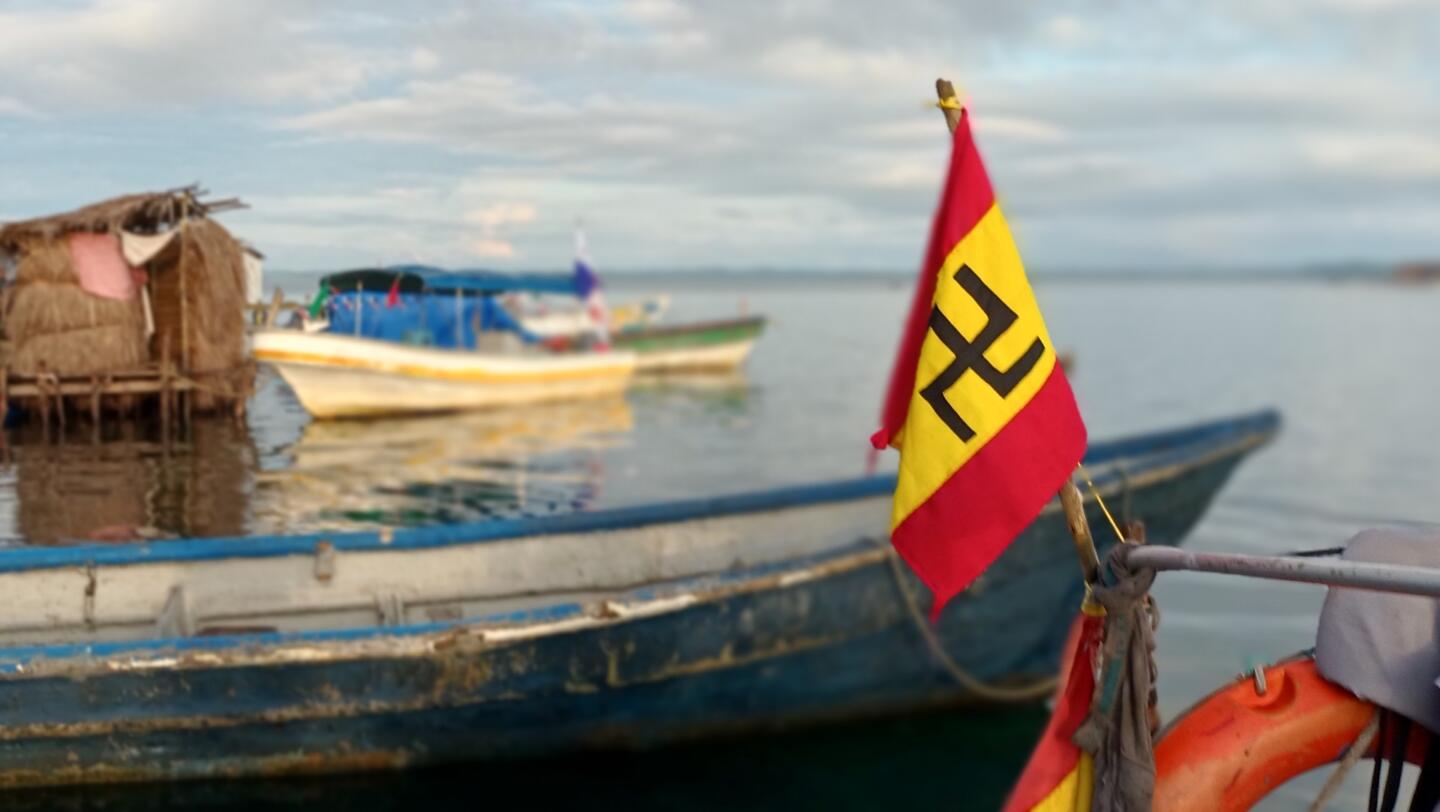I arrived there planning to tell the story of a tragedy caused by the rising sea levels. By the time I left I understood that beyond the climate threat there was overpopulation and abandonment, but there was also resilience and a future. The island that was supposed to disappear has actually increased in size in recent decades. Because everything is more complex. Much like the lives of the Guna indigenous people.
I came to Panama to report the story of a small, flat island whose days are numbered. A story about how the vast and calm surrounding ocean will one day submerge it. This tiny island is called Gardi Sugdub and it is overpopulated by about 1,300 people, the vast majority made up of the Guna ethnic group.
Before coming here, I devoured academic studies, reports from environmental NGOs, scientific analyses, opinions of activists and bureaucrats of all stripes and reports in several of the most reputable newspapers in the world. I read the Guna were doomed to abandon their islands, I read comparisons of Gardi Sugdub with the mythical Atlantis, I read it will be the first community of climate displaced people on the continent, and I even read the exodus would occur in one to two years. I read the latter in an article published in 2017.
But by the time I left there, I understood that everything is more complex. As it almost always is. Just like in life.
Today is the second of my six days in Gardi Sugdub and its chief, or Saila, José Davies, has agreed to talk to me. Sailas are the highest authority in each of the 49 Guna communities, figures who command a mystical respect. José Davies is 82 years old, dark-skinned, barefoot, his eyes small behind large, high-end glasses. He speaks very softly and only in Guna, his language.

José Davies (left) is the Saila, or chief, of Gardi Sugdub. He is the island’s main authority. On the right, there is a Co-official flag of Gunayala, adopted in October 2010
“An abege be inniggigwadba ibmar sogged Gardi Sugdub negweburgi sunmaggalir,” he says to me almost at the end, in a tone that sounds like scolding.
Saila José Davies has been –and still is– one of the most enthusiastic promoters of the relocation to the mainland, but he denies that it is because of fear of the Caribbean Sea, of his sea, and even seems to be offended by the idea of Gardi Sugdub being submerged.
“What our Saila said,” Betzander, who is also Guna, translates, “is that he wants you to tell the whole truth when you talk about Gardi Sugdub.”
I hope I’m up to it, Saila.
***
When the writers of the series Money Heist scattered the protagonists around the world after the assault on the National Mint and Stamp Factory in Madrid, the impulsive Tokyo and the playful Rio were hidden away in the Guna Yala archipelago. Gardi Sugdub is one of its 370 coral islands and islets. The screenwriters of the acclaimed Spanish series chose wisely: well into the twenty-first century, the territory of the Guna people is still a hard-to-reach place.
The small port from which the boats depart to Gardi Sugdub is 40 miles (65 kilometers) as the crow flies from Panama City, but it took more than five hours for our pick-up to get there. Repairs are being carried out on that road now, but the 25 mile (41 kilometer) stretch from the Pan American Highway to the Caribbean was a form of medieval torture until very recently.
Isolation has been a constant in the history of the Guna. A brief sketch of the past five centuries of this people could be summed up as follows: at the beginning of the sixteenth century, with the arrival of the conquistadors, the Guna were settled in the Caribbean coast of what is now Colombia, around the Gulf of Urabá; Spanish persecution and rivalries with other ethnic groups pushed them to migrate towards the forested mountain range of San Blas –now Panama–, which ensured they were remarkably isolated; as the decades and centuries passed, they gradually migrated back towards the coast, more exposed to the Spanish, English, French, Dutch, and Scottish galleons; by the mid-nineteenth century, the Guna began to settle in the archipelago –including Gardi Sugdub, supposedly to escape malaria and yellow fever; when, in 1903, Panama declared independence from Colombia, the new State tried to assimilate them culturally and repressed them, the Guna took up arms and proclaimed their independence –the short-lived Republic of Tule and its brazen flag (which we’ll come back to later)– for a few weeks in 1925; and from 1938 onwards, autonomy became the law of the Republic of Panama, under pressure from the united States, which preferred to save itself from open conflict within a few miles of its Panama Canal.
And so it was, until now.
Some anthropologists are convinced that the Guna are one of the indigenous peoples who have most successfully preserved their culture, language and territory. Currently, there are an estimated 60,000 speakers of Kuna, the overwhelmingly dominant language in Guna Yala, the political-administrative entity which, within the Panamanian state, grants extraordinary autonomy to the Guna people. When you talk to their men and women, there is no doubt that they feel a singular pride in their history of resilience, almost as much pride as that of Asterix and the other residents of that village of indomitable Gauls who always resisted the invader.
For the Guna, the most crucial threats right now are not the survival of their language, or loss of identity, as they are for so many other indigenous peoples. Instead, the most imminent threats are the Caribbean Sea and the climate crisis.
But as I said, everything is more complex.
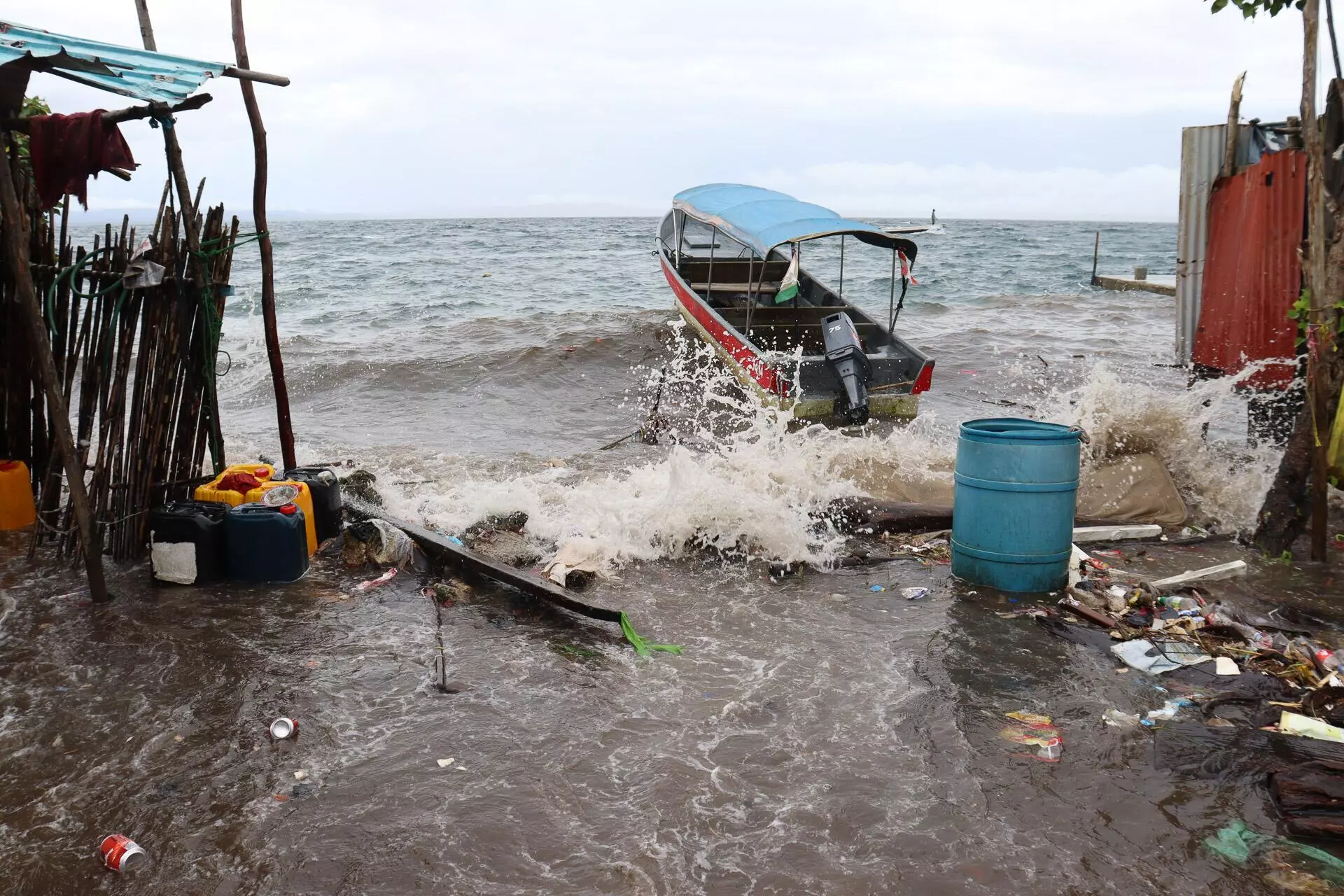
On 21 November 2022, there was a minor flooding of the north-western sector of Gardi Sugdub, a common occurrence in the last months of each year
***
“The project started because of overpopulation, not because of climate change,” Saila José Davies told me. A couple of minutes earlier he had thrown out an equally defiant: “The sea does not scare us Guna people. Quite the opposite!”
Without a shadow of a doubt, the Caribbean represents a real, growing and measurable threat. Gardi Sugdub is a fairly rectangular island measuring 984 feet (300 meters) long and 410 feet (120 meters) wide; the size of five football pitches. It was smaller 20, 30, 50 years ago; later you will understand the apparent paradox. There are about 160 spacious houses on it, and about 1,300 people. But the real problem is its flatness, which, if we only stick to the projections of rising sea levels due to global warming, means it is doomed.
Two narrow dusty streets cross the length of Gardi Sugdub. Leading off them and between them, are a tangle of even narrower dusty passages all leading to the sea, to the little piers. It is almost entirely houses –the most precarious and the least proper– but there is also a school, a tangle of cables, cats, a health post, solar panels, bedsheets, satellite dishes, plastic, bunting, laundry drying, blue plastic drums, more cats, an out-of-place telephone booth near the central pier, puddles, chairs and even more cats.
What Gardi Sugdub does not have are parks or a shopping center or asphalt or fountains or banks or nightclubs or pizzerias or cinemas or skateparks or sidewalks or cars, traffic lights, motorcycles or urban bustle or shady trees or municipal police or brothels or statues or a little square. Gardi Sugdub doesn’t even have a cemetery to bury its dead.
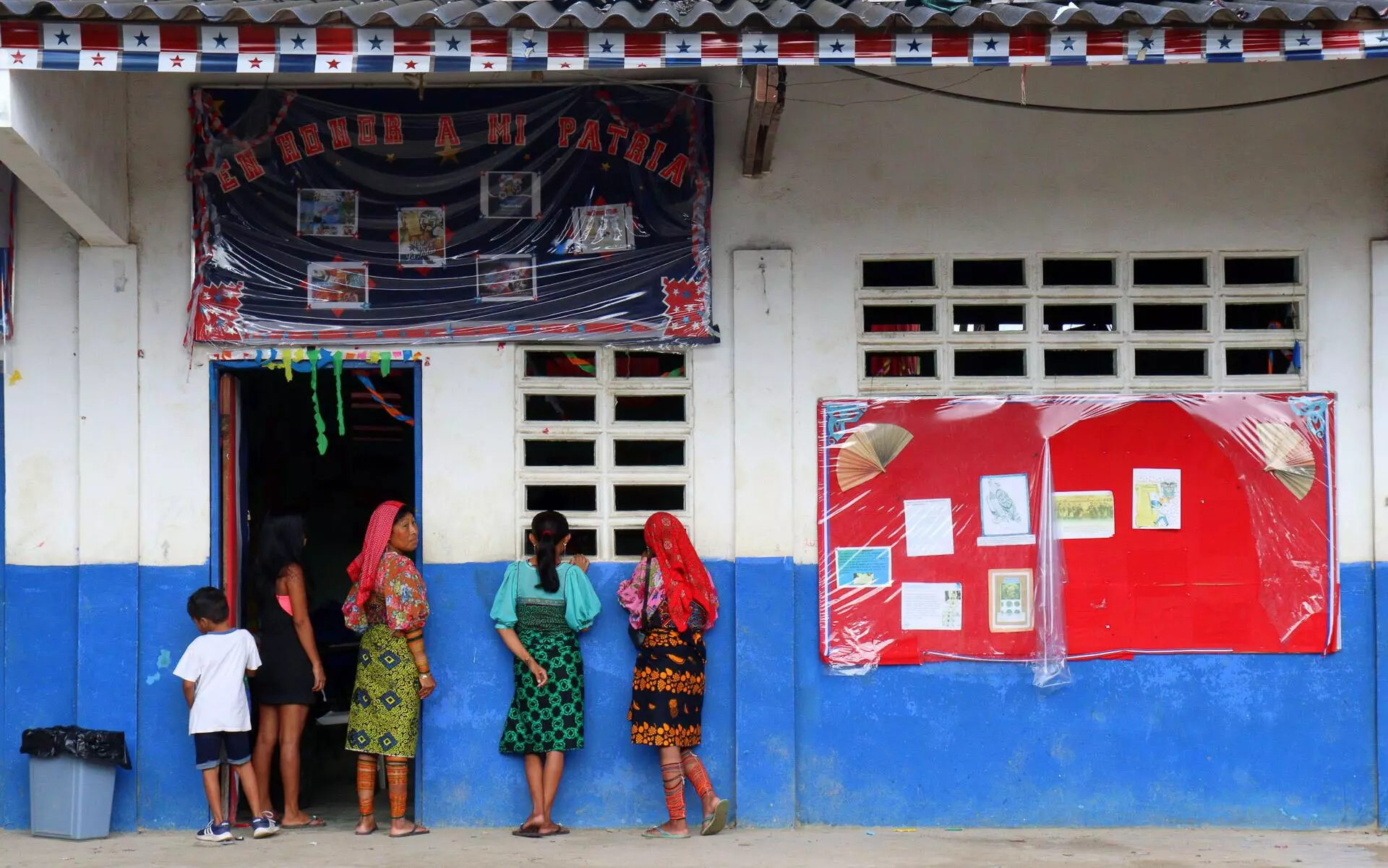
Three mums in traditional clothes wait for their children to leave school in Gardi Sugdub
25 years ago, at the eastern end of the little island, there was a small pitch for football and basketball. The school is in the heart of the island and, when engineers warned that the weight of the two-storey building was a danger, the community got together, weighed and opted to dismantle the upper floor and build those classrooms on the only available space: the sports pitch.
Overpopulation.
“I am one of those who pushed for the relocation,” Saila José Davies told me. “I know the whole story, but I’m old now; Mr. Albertino Davis can explain it to you better.”
Albertino Davis is 68 years old and is also Guna. When I interviewed him, he was chairing what is known here as the La Barriada Committee, the group of neighbors that liaises with Panama’s Ministry of Housing to coordinate the construction of a community of 300 houses on the isthmus. But more detail on all that later.
It was 15 years ago when Saila José Davies and other revered elders –almost all of whom have now died– came up with the idea of erecting a settlement outside Gardi Sugdub. Saila himself offered a plot of land.
“We were going to build our houses ourselves, because many families could no longer fit,” Albertino explains.
It has been more than 15 years since that small group of Guna leaders from Gardi Sugdub began to get organized, for the sake of their grandchildren and great-grandchildren.
***
The seas are rising on Earth; it doesn’t matter whether you believe it or not, whether it worries you much or not. The level rose by an average of between 6 and 10 inches (15 and 25 centimeters) –recorded, contrasted– from the beginning of the twentieth century until 2018, with the most pronounced increase in the middle decades. In the world scientific community, there is also a widespread consensus that it will continue to rise millimeter by millimeter during the twenty-first century.
Apologies for stating the obvious, but the risk posed by the oceans is more so in coastal areas with minimal elevations; the low-lying islands, especially. And as interest grows in the predicted tragedies, since the end of the last century a kind of atlas has been collated, showing the territories that will be flooded sooner or later.
The paradises of the Pacific Ocean are directly in line: the Marshall Islands, Kiribati, Tuvalu, Fiji … Besides the Oceania of Disney’s Moana, rising sea levels is of great concern in places as disparate as the Maldives or Jakarta (both in the Indian Ocean), Prince Edward Island (Canada), Saint Louis (Senegal), New Orleans, Venice the Netherlands…
In Latin America, the Guna Yala archipelago was the iconic place chosen by the United Nations System to raise awareness about the global threat; and among its more than 370 islands, one in particular: Gardi Sugdub. By pointing out the place, no matter how remote, it was not long before journalists, scientists and politicians were dropping in.
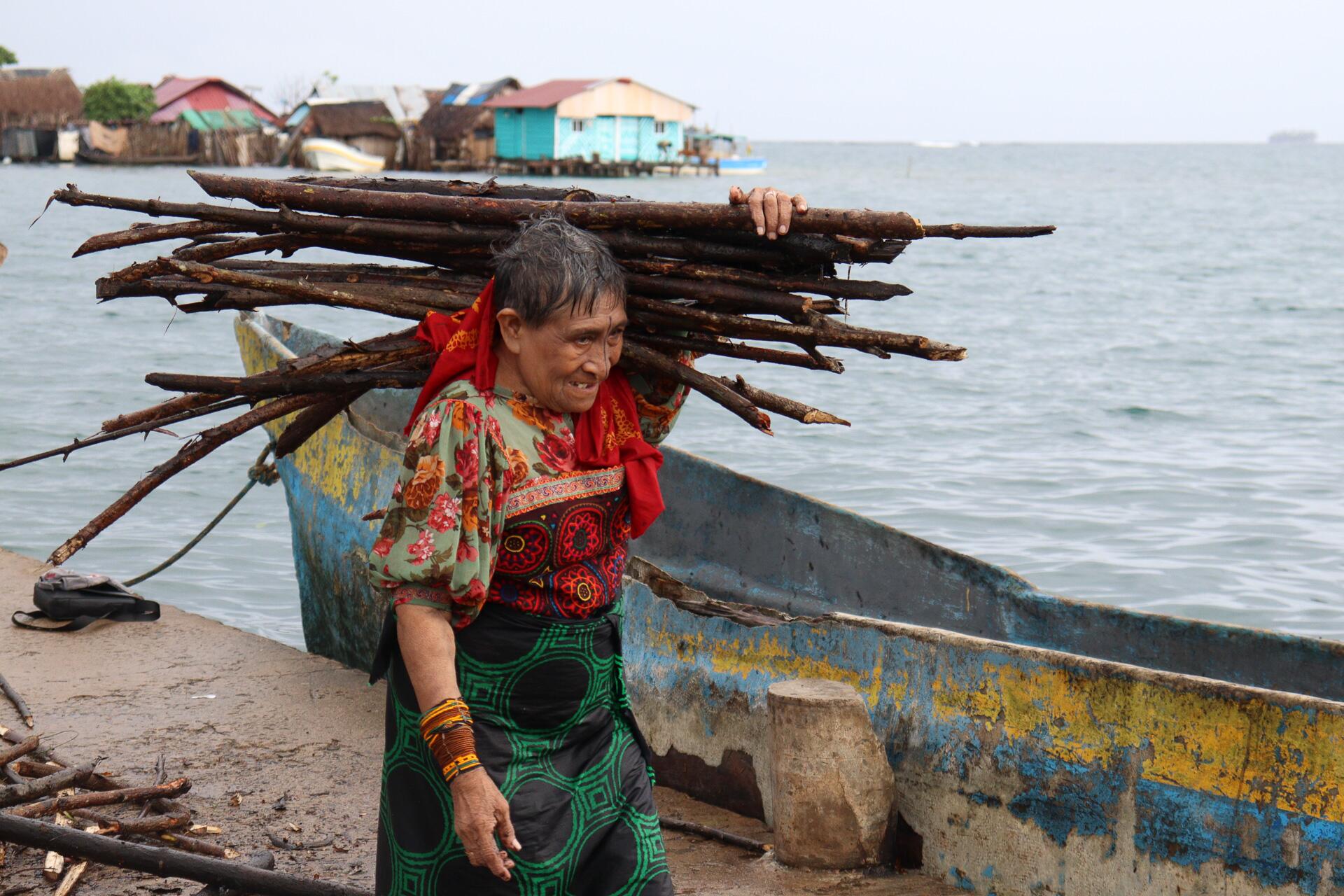
Fidelia Denis Ponce, 76, carries the sticks from the dock to her home; this is a task usually carried out by Guna women
***
His granddaughters and great-grandchildren – his future – are the ones who from the beginning led Sergio López to embark on the idea of building a mainland community. Sergio –44 years old, father of three sons and two daughters, and Guna, of course– earns a living selling fuel for boats, with a small shop in his home, and working as a tourist guide. On his phone he has a photograph of him with Rio from the time when Money Heist was being filmed in Guna Yala in late 2018.
“I worked on clearing the land that we chose initially for La Barriada; I worked with my dad.
Sergio tells me this in the shade of some palm trees in Assudub Bibbi, a postcard-like island, dotted with fancy beach huts, hammocks and a net for beach volleyball, a holiday destination for wealthy tourists, located 9 miles (14 kilometers) northeast of Gardi Sugdub. Betzander Arango, 43, also a tour guide and occasional translator, joins in the conversation.
Of the entire archipelago, Gardi Sugdub is one of the most affected by overpopulation, not so much by flooding. There has been a desire to make it less crowded for a long time, at least twenty years, and has been encouraged by the Saila José Davies and other elders. But something changed in 2008.
In November of that year the waters were extremely rough in this part of the Caribbean. Because of the moons and winds and tides, in Guna Yala it has always happened, almost every November and December, but in 2008 there were more flooded areas, and for longer. Even the semi-annual meeting of the Guna General Congress, which was supposed to have started on the 27th on Dadnaggwe Dubbir, an island located 62 miles (100 kilometers) to the east, had to be postponed.
Although Gardi Sugdub was not one of the islands most badly affected, it was after those floods that the old notion of relocating to the mainland really began to take hold, albeit at a Caribbean pace. In mid-2010, there were only 30 interested families; among them, Sergio’s, who had to clear part of the jungle with José López, his father.
In those years –2008, 2009, 2010– concepts that do not exist in the Guna language also began to be heard in Guna Yala and are still interspersed in Spanish to this day: global warming, and climate change.
***
“I was born here and I will die here,” Ernesto Ávila tells me.
Ernesto is 60 years old and he is a down-to-earth, old-school tour guide, one of those who today try to butter up the American and European pensioners who disembark for a few hours on the island. It is not even 7 am on the morning of my first sunrise in Gardi Sugdub. I rose before the sun and my walk —camera in hand, to take advantage of the best light— ended up at the central pier. There I was, lost in thought, when Ernesto shouted at me, beckoning me over to his house, on the shore.
He greets me in shorts and flip-flops, clutching a bottle of Bacardi. He wants to know who I am, why the photos. He calms down when I tell him that I’m a journalist and that yes, yesterday, just off the boat, I paid the 100 dollars of “community tax” with invoice and stamp, the fee they charge journalists to take photos freely without complaints from the community. He offers me a chair and a coffee. He’s dying to tell me about his ambitious plans to get himself out of poverty.
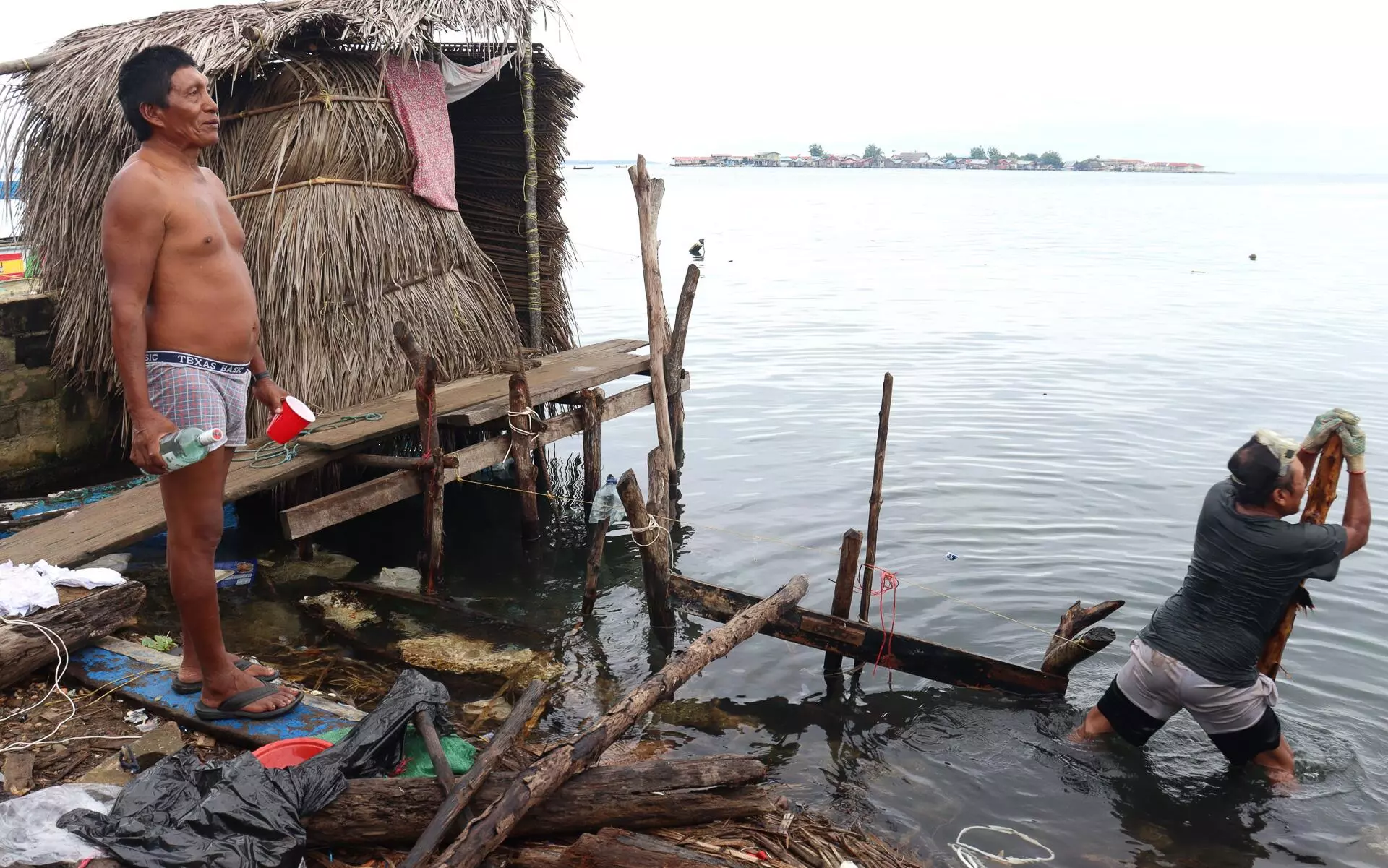
Ernesto Avila oversees the backfill that will allow him to extend his property by a few metres
In front of us, next to a shabby cubicle constructed from pressed leaves (wagaras) which acts as a toilet, there is a man submerged in the sea, the water up to his chest and a snorkeling mask on his forehead. His name is Arcadio, and he is filling in.
Also in front of us are Gardi Dubbir and Gardi Yandub, at 900 feet (300 m) and 1600 feet (500 m); two islands that are not as big or as overcrowded, but enough to have their own authorities, their own Saila. And closer, Coibita Island, an elongated piece of land that in recent decades the Gunas have plundered from the sea, by filling in. Coibita is home to about 15 families and they still depend on the Saila of Gardi Sugdub.
Just four days ago, a tweet was published showing a satellite photograph of the four islands, taken from the European Space Agency’s Sentinel-2, and disseminated by accounts related to Europe. “The 1,200 inhabitants (of Gardi Sugdub) will soon be displaced to the mainland due to rising sea levels caused by #climatechange,” reads the tweet. I show it to Ernesto.
“Lies! That’s a big fat lie! Why are they lying to the planet? Why would they lie like that?”
The proof that he is serious lies in what Arcadio is doing: Ernesto has hired him to fill in, to extend his property.
Filling in is relatively simple and the Gunas have been practicing it since ancient times. Six to ten feet (two or three meters) from the shore, at a shallow depth, they hammer in large canes and attach planks of wood to them, which act as a retaining wall. Then, they put down large rocks extracted from the reefs; for a better hold, Ernesto places them on top of the wreck of his old boat. “Then they join it up, fill it in, as you can see right now,” Ernesto says. The key is the large coral rocks, and the medium ones, which are stacked in an orderly way, although all kinds of solid garbage and non-organic waste are also used. Lastly, it is covered with earth or concrete, depending on the budget, and then the wall is removed. And so, the Guna can walk over what was, just a few days ago, the Caribbean Sea. With what Arcadio is doing right now, they will reclaim about 30 square feet (10 square meters) from the sea.
“I’m happy here,” says Ernesto. “One day I’d like to have a bar here, for tourists, or extend my house more and put it up for rent on that Erbienbi thing.”
Half done, it looks pretty unstable, to be honest, but the truth is that by using this filled in land Gardi Sugdub is more extensive and elevated today than it was half a century ago. For this reason, and because of the pride the Guna show for their life on the islands, it seems impossible that this will one day be evacuated, that it will be underwater.
“We old people like filling in; if you’re increasing your family, you have to do some filling in, to then pass it on to your daughter,” Albertino Davis, the one from the La Barriada Committee, tells me a few hours later.
“My cousins have just built a house on Coibita Island,” Betzander tells me the next day.
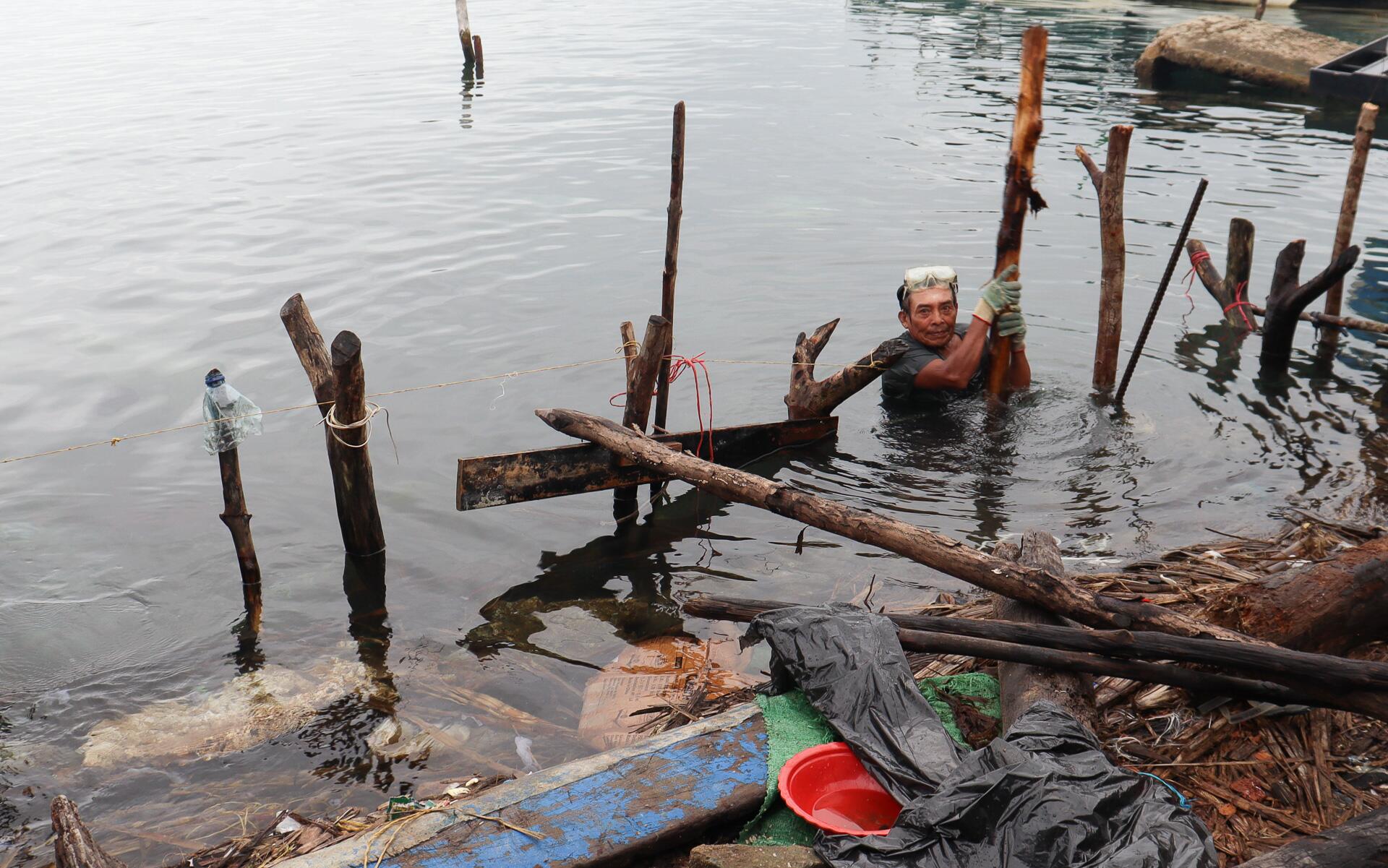
Arcadio works on the wall that, once the filling is finished, will serve to gain metres from the sea
***
Global warming and climate change started being talked about in Guna Yala, very gradually. The first article on record that raised the idea was published on August 30, 2010, in Mi Diario, one of Panama City’s leading daily newspapers. The report, entitled “See you later, dear island”, talks about a piece of land on the mainland that has been cleared –deforested– in order to house just 30 families, about 150 people.
The text contains an explicit reference to climate change and states that there were already talks going on with the Panamanian government to finance the initiative.
“Ever since I was a child, in Guna Yala there have been strong gales, waterspouts, high tides, and the Guna people, we’ve always just been here, surviving,” the octogenarian Saila José Davies tells me, more than a decade after that article was published.
Unrelated to the relocation proposed by the Saila of Gardi Sugdub, the government launched two projects, which taking into account the reality of the region, well deserve to be described as pharaonic. With a budget exceeding the 11 million dollars borrowed by the Inter-American Development Bank, an ambitious school complex (library, laboratory, gym, dormitories…) and the most modern and equipped health center for Guna Yala were designed; both on dry land, one next to the other, a mile (1.5 kilometers) north of the small port.
They were tendered and construction began during the administration of Ricardo Martinelli (2009-2014). Martinelli was succeeded by Varela; and Varela by Cortizo, and both the school and the little hospital are still half-finished, abandoned. A textbook example of a white elephant (that’s the title of the movie starring the great Ricardo Darín).
The historical neglect of the state towards the Gunas was also reflected in the relocation project. The conversations between the seedling of what would eventually become known as the La Barriada Committee and the government, crystallized in 2011 into a plan to build a community for 65 families on the mainland.
Baptized as Nuevo Carti, it passed into the hands of the Ministry of Housing and Territorial Planning, the MIVIOT. Consultations, studies and proposals were made, plans were drawn up and even an investment of 2.4 million dollars was set… but no first stone was ever laid.
Not a single house, but those ups and downs served at least to plant three ideas: the first, concerning the community of Gardi Sugdub itself, was that, since the 30 families interested in the beginning became 65 families, they agreed that the new ones would make an economic contribution to the Committee to compensate for all the work done by the original ones. This model was replicated years later when the number of houses jumped up to 300.
Secondly, the Gunas resigned themselves to accepting small homes within a large lot; the model house for Nuevo Carti was barely 390 square feet (36 square meters) of construction, within a property of 4,900 square feet (450 square meters).
And thirdly, the initial romantic idea that La Barriada should be built using original materials, similar to those that the elderly people knew when they were young, was discarded. Something like that would have made everything more expensive, and pragmatism was chosen.
This is how Dilion Navarro, the 56-year-old Guna who was chosen by his community as a liaison with the construction company currently trying to complete the project, explained it to me: “Even in Gardi Sugdub there are already very few traditional houses left, unfortunately, because zinc sheets are cheaper than a roof made from traditional wagaras; Guna people are already used to living like this, so it’s not a problem that they are houses like the ones in Panama City.”
“I know that my children will like it better in the new community, especially the youngest ones, because they will watch TV all day, they will have air conditioning,” Sergio tells me. “The small power plant that supplies Gardi Sugdub with electricity goes off at night.”
Anyway, as I said: Nuevo Cartí turned out to be a sham.
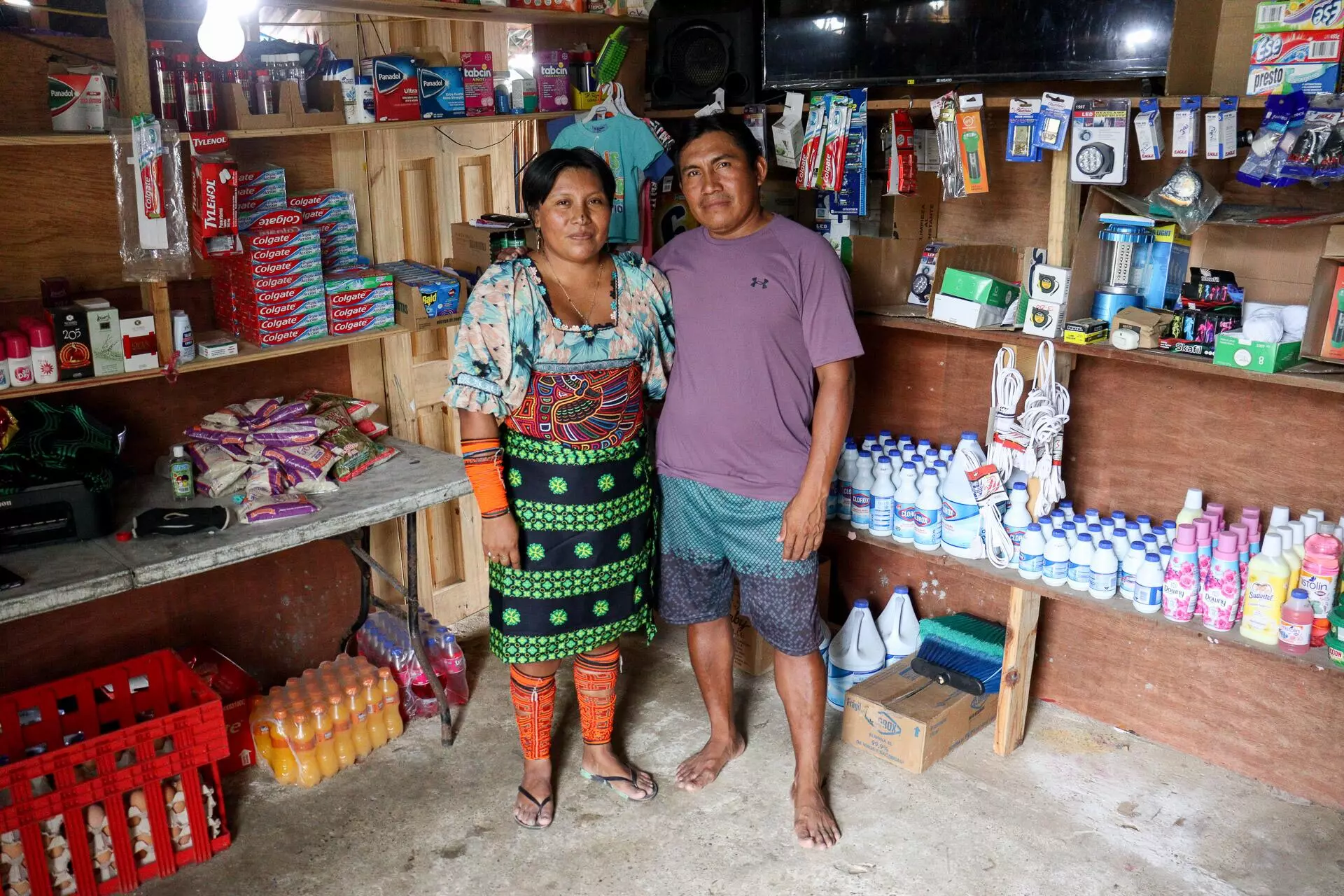
Yanicela Oyuri Vallarino and tour guide Sergio López in the small shop opened in their house
***
The Guna people have the swastika as their flag.
One of the two flags of Guna Yala is red-yellow-red, traced to that of Spain, but with the large black swastika in the center. Its brazenness is shocking. In Gardi Sugdub, I’ve seen it everywhere: fluttering on poles, in houses, in boats, at the meeting house and in the chicha fuerte house, daubed in graffiti, printed on souvenirs.
“Everyone thinks it’s because of the Nazis, but for us it has another meaning,” Deliano Davies, who runs the self-proclaimed Museum of Guna Culture, tells me.
The Gunas hoisted this flag in 1925 for the first time, during the Tule Revolution, the armed uprising that led to broad political and administrative autonomy of this people within the Panamanian state. A century later, the flag is still a fierce source of pride.
There are several hypotheses about how the swastika ended up there, in a decade in which it was a symbol of Aryan supremacism in the West: one claims that it was drawn by the granddaughter of one of the leaders of the revolt; another, that the swastika is an identifying symbol that goes back to the mystical origins of the Gunas.
And another theory –the most solid, in my opinion– points towards the ravings of the American explorer and diplomat Richard O. Marsh, who had come to Guna Yala looking for rubber a few years earlier. Marsh became obsessed with the idea of having found, among the Gunas, a lost branch of the Aryan race, befriended the leaders, won the sympathy of the United States government, and encouraged and spurred on the indigenous people against the Panamanians. His ethnological obsession, embodied in the book The White Indians of the Darien, led him to take two white-skinned Guna boys and a girl aboard a ship to New York, to prove to the scientific community that they were descended from Scandinavians. “My three little girls looked like healthy Norwegians, not biological monstrosities,” he dared to write in his book.
In the end, they turned out to be albino Gunas. Ibegwa, in their language.
***
Nuevo Cartí turned out to be a sham, but that first half of the 2010s was key in the rise of the climate crisis on the global agenda. The United Nations System endorsed the warnings that rarely went beyond academic circles, and the Gunas in general –and Gardi Sugdub, in particular– began to fly the flag of the dire consequences of rising sea levels.
The Government of Panama realized the potential, and in 2015 prepared the dossier for the community of 300 houses that is still being built today, next to the aborted white elephant.
Since Paris 2015, the Guna people and their Caribbean Sea have snuck, hand in hand with the Panamanian Ministry of Environment (MiAmbiente), into every Conference of the Parties (COP) organized by the United Nations. Initially without even consulting the Guna General Congress, then with increasing coordination, to the point of integrating indigenous leaders into official delegations such as COP-27 in Sharm el-Sheikh (Egypt), which was held on the same days I was reporting in Gardi Sugdub.
But when it comes to actually constructing the new community, it’s been eight years of all talk and no action.
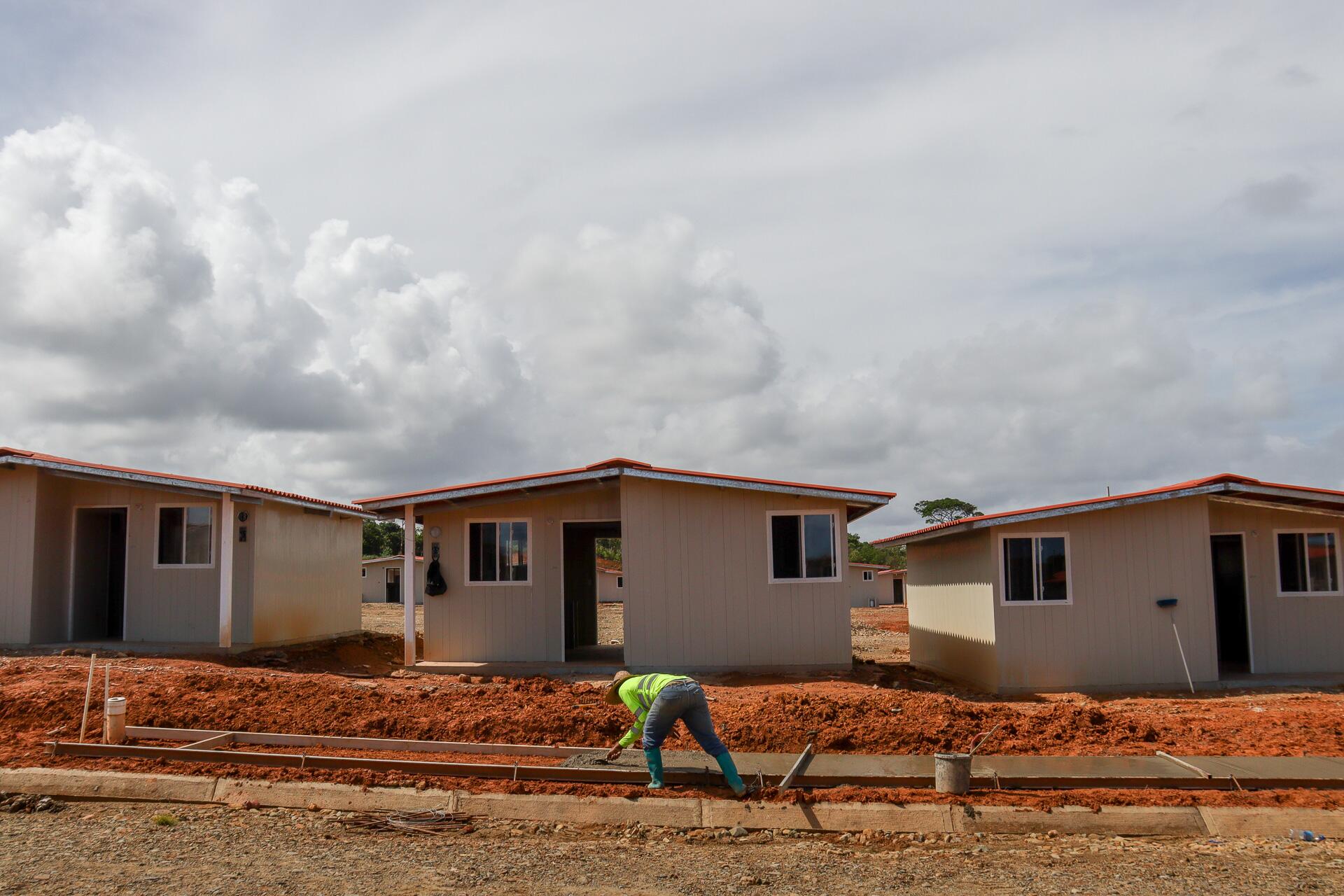
The 300 houses that make up Isber Yala are scheduled to be handed over to the Gunas of Gardi Sugdub in February 2024
“The plans were submitted to the community, and they were approving how it was going to be developed,” Marcos Suira, MIVIOT’s director of Engineering and Architecture, told me in his office in the capital.
“The works have approved financing, more than 12.2 million dollars, but those funds became the piggy bank that the government smashes open when there’s any unforeseen event.” When Hurricane Otto struck the provinces of Colón and Bocas del Toro in November 2016, the Guna relocation was postponed. When the pandemic came, ditto. And when in July 2022 they unleashed the most widespread protests in the country’s recent history, the Presidency has once again defunded construction to meet new commitments.
I visited La Barriada on the last of my mornings in Guna Yala, and the building works were practically at a standstill. Officially, the progress was at 64%, but the months of abandonment were already taking their toll.
“There is still a long, long way to go, and because everything is behind schedule, any progress made is now deteriorating: the streets are eroding, the houses are overrun with weeds, things are rusting…” Dilion Navarro told me, almost enraged.
One thing that is definitive is the name of what would become the fiftieth Guna community: Isber Yala, because loquats (isber, in Guna) were abundant in the deforested zone, an area 1.3 miles (two kilometers) away from the coast, which would not even be affected by the most destructive tsunami.
***
It’s raining hard on Gardi Sugdub and the sea is rougher than usual. The waves are no more than 10 or 15 inches (30 or 40 cm) high, but there is a high tide, and the westernmost part of the island is becoming flooded. Despite everything I’ve heard in the four days here, for a moment I think I’m witnessing the beginning of the end of this island. This has to be recorded.
A few steps from the shore, the sea water reaches up to my ankles and goes about 130 feet (40 meters) inland, until it merges with and disappears into freshwater puddles of the downpour. A group of white tourists are also curious and taking photographs, surprised. Not so the Guna grandmother who sits on a plastic chair, dressed in her traditional brightly colored garments, her mola fabric, her beaded jewelry, her orange scarf wrapped around her head. At the same time, in another chair, sits her granddaughter, maybe seven years old. They act as if nothing is going on 30 feet (10 meters) from where the little waves are breaking. As if nothing is happening.
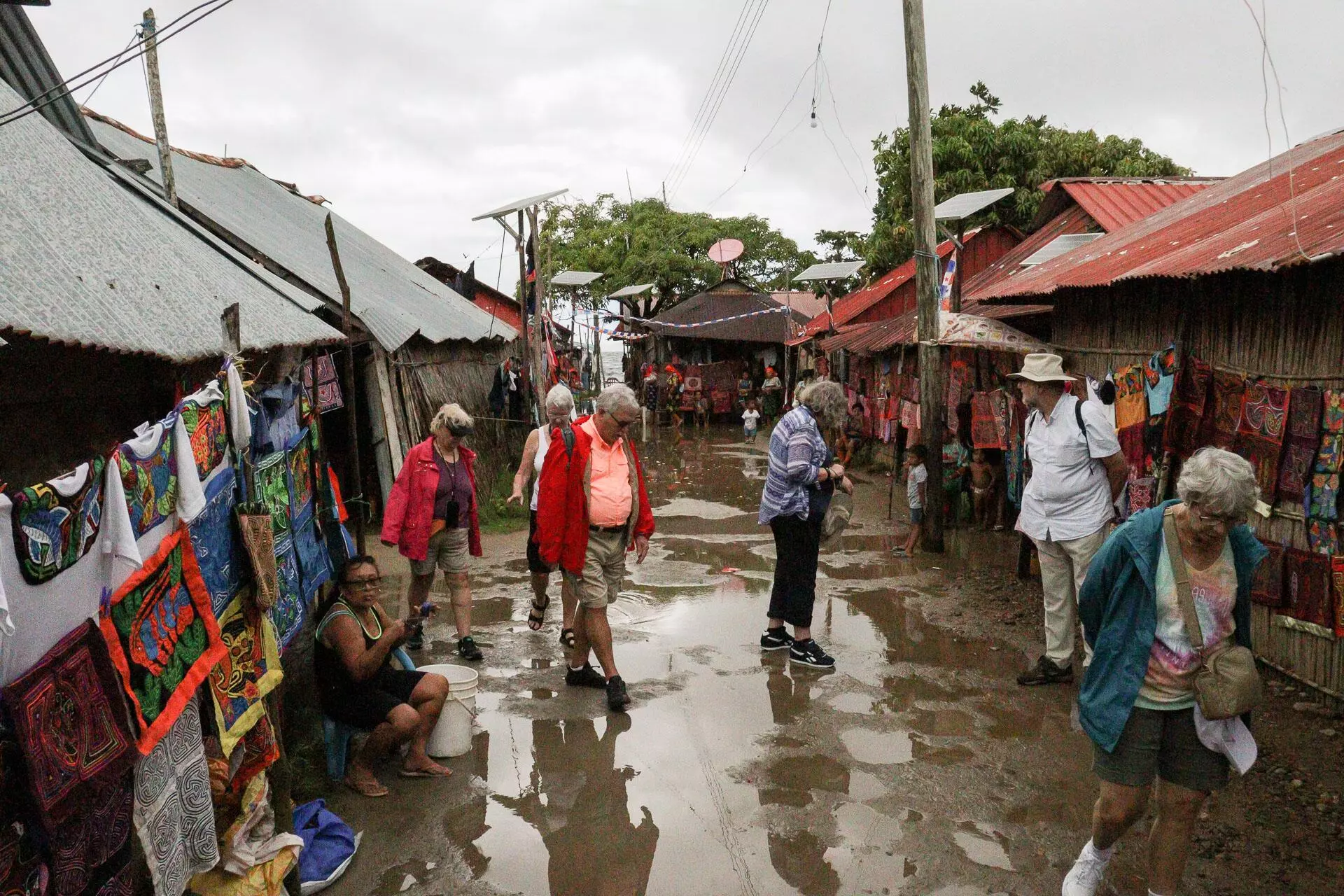
It’s November. November 21, and, like almost every November and December in Guna Yala, the waters are churning because of the moons and winds and tides. The grandmother’s concern, I gather from her broken Spanish, is that the flooding is happening on the day that a cruise ship has anchored in front of Gardi Sugdub, and for a couple of hours about 200 potential customers of the souvenirs she sells have disembarked.
It’s not just any boat. It is the Royal Clipper, a five-masted, 440-foot (134-meter) sailing ship, the most luxurious of the ships of the European cruise company Star Clippers Ltd., for which the Caribbean Sea is one of its most sought-after destinations. The Royal Clipper is listed in the Guinness World Records book as the world’s largest square-rigged ship in service. In a few hours, when it has stopped raining, Sergio will take me to go around the ship in his boat, to admire her, and she is truly impressive.
The vast majority of the 200 touri$t$ who disembarked stroll and shop around the rest of the island, which is decked out for the occasion. They move in little groups. They are the prototype of the Northern European pensioner, all a certain height, a certain paleness, with their gray hair, their shorts and T-shirts, their white socks and their expensive cameras. The wet dream of the supremacist Richard O. Marsh. Each of them has paid between 5,200 and 10,300 dollars for this cruise that departed from Panama City, crossed the Canal, and in 13 days will dock in the capital of Antigua and Barbuda, the end point of the journey.
Gardi Sugdub is the first stop. They have been receiving this type of cruise ships for decades and there is a very developed sense of affectation. Like this girl of six or seven, dressed up like a postcard, who, in exchange for a note, allows her photo to be taken, smiling with a toucan on her shoulder. Boys and girls with little animals are guaranteed earners; I’ve seen them with kittens and puppies, but the one with the toucan, without a doubt, really draws a crowd.
In just over an hour the hordes of tourists will return to the Royal Clipper –heading for Cartagena de Indias, the souvenirs will be put away until next time, and much of the color of the streets and narrow passages will disappear. It will last a few more hours, the ocean will have taken its revenge, spewing plastics and garbage and waste into the flooded areas, but the waters will end up receding… until the next flood in Gardi Sugdub.
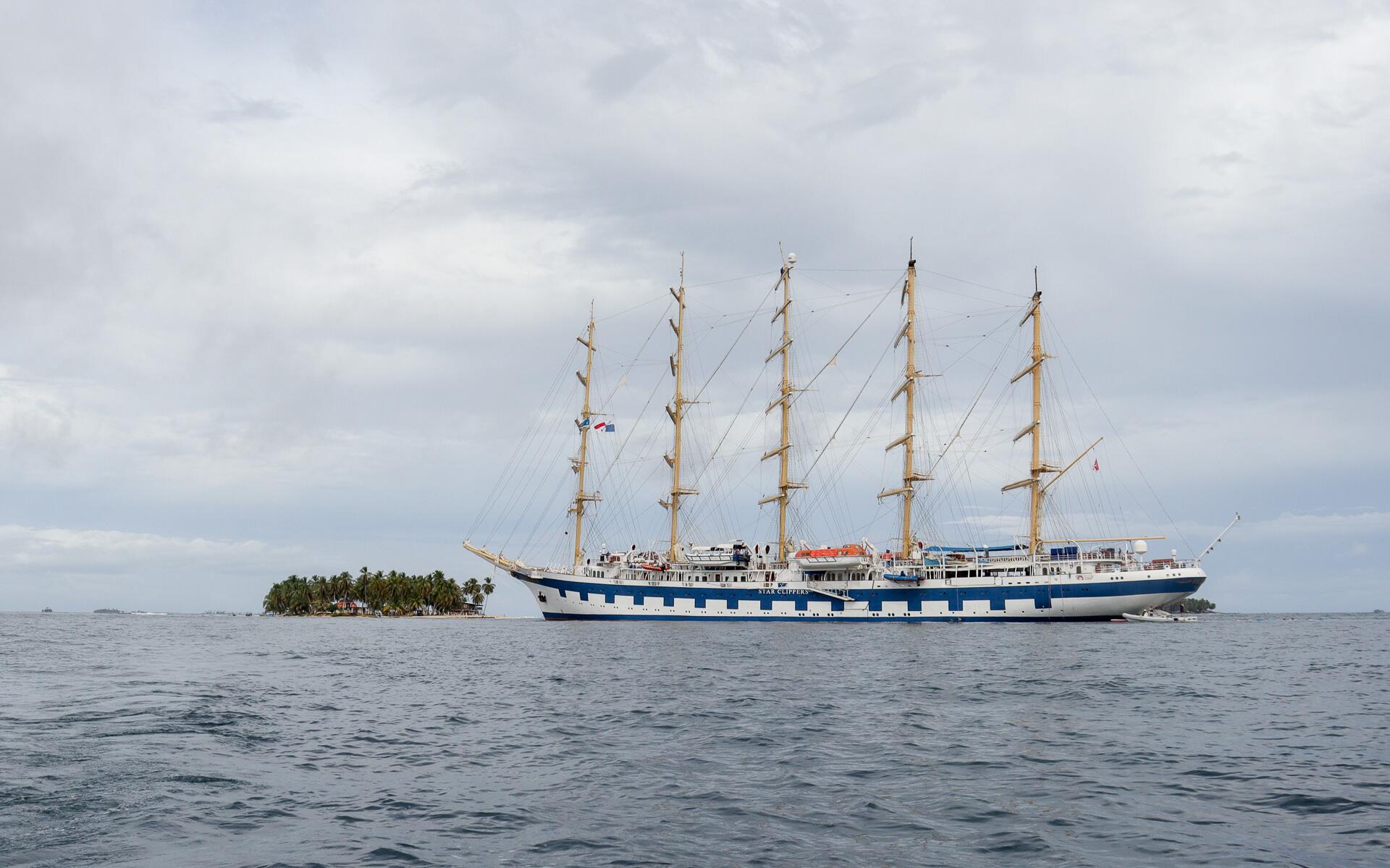
***
The most destructive tsunami on record in Panama occurred on September 7, 1882, after an earthquake of 7.9 degrees on the Richter scale, with an epicenter in the heart of the Guna Yala archipelago. The waves were over ten feet (3 meters) high, they devastated all the islands and the coastal areas, and the estimated death toll was between 75 and 250.
Although it happened a century and a half ago, that tsunami came up in my conversations with the Gunas of Gardi Sugdub when we talked about their (non) relocation to the mainland. The Guna people rose up stronger after the trial that Babdummad (the Great Father) and Nandummad (the Great Mother) put them through; they did not abandon their islands because of that infinite devastation. They proudly tell this story.
According to the Third National Communication on Climate Change report drawn up by MiAmbiente and presented in 2019, the sea level increased by 1.5 inches (36 mm) between 1992 and 2012, which is equivalent to the length of BIC pen cap, without the little tail. one and a half inches (thirty-six millimeters) in two decades. The fact that their ancestors stayed on their islands after a tsunami generating waves of 118 inches (3,000 mm) is something that stays with them. As well as the conviction that filling in is a reliable antidote.
“The sea level is going to keep rising, and the swells are going to keep happening, and the warming, and the acidification… Yes, we have to be prepared for it…” marine biologist Maribel Pinto, head of the Climate Change Adaptation Department of MiAmbiente, told me.
When I asked her if she thought that in 10 or 20 years Gardi Sugdub would be depopulated or submerged, as so many colleagues have casually published, Pinto replied that it is up to her government to ensure that as few people as possible are living there, but that if living on the islands “is part of their culture, of their connection, we will have to respect it.”
At this point in the article, it should be made clear: Gardi Sugdub will neither be a twenty-first-century Atlantis, nor will its 1,300 inhabitants be the first community of climate displaced people in Latin America.
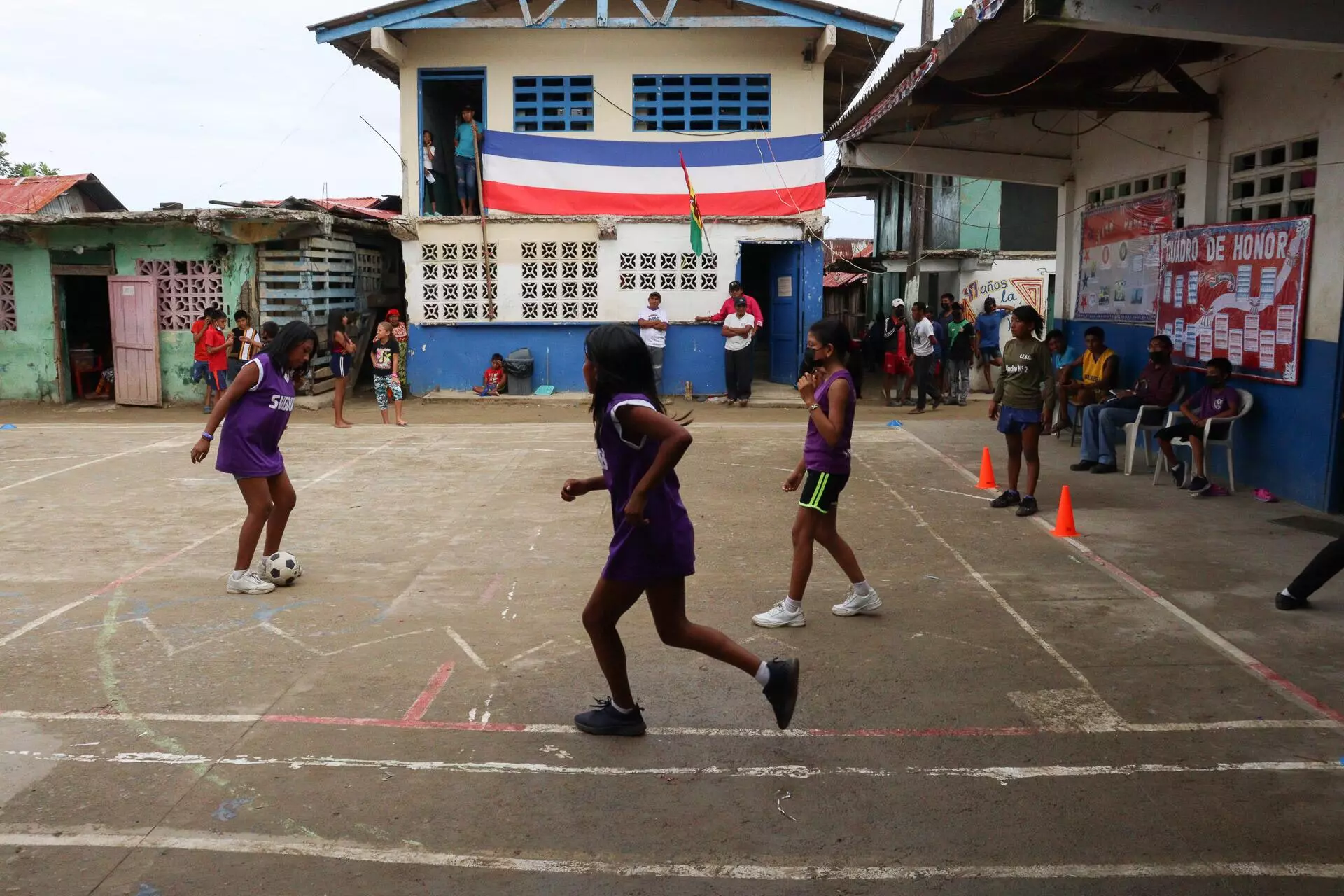
Girls play football in Gardi Sugdub’s school yard
***
“You have to bathe in the river,” Sergio tells me.
“Seriously,” a shirtless Betzander says, seeing the look of confusion on my face.
It’s still a couple of hours until dusk and we are at a bend of the Cartí Grande River, in the middle of a jungle forest of intense greens. We have just left the cemetery of the Gunas of Gardi Sugdub, a privilege that I have not yet finished processing, but which is making me feel like DiCaprio on the bow of the Titanic.
One of Betzander’s old teachers from childhood passed away yesterday. He wanted to pay his respects and asked me to go with him. A couple of hours ago, the three of us got into Sergio’s boat and sailed first the 1.25 miles (2 km) to the mouth of the Cartí Grande, and then the same distance again upstream. We are on dry land; not so far from Isber Yala, by the way, although with dense jungle in between.
The cemetery –neguan, in Guna– is not showy, but it is functional. A succession of roofs, most of them made of zinc, some from interwoven agave leaves. Each structure belongs to a family. No crosses. The ground is uneven and there is not much order.
When we arrived, about ten older women with their suits, molas and multicolored beads offered us a seat, lunch and smiles. From a large, deep container we ate with our hands, an overcooked but delicious rice. They have been talking in Guna, and laughing; nothing like any of the funerals I have attended in my life. It was an almost festive atmosphere. After lunch, we went to the place where the dead man was, wrapped in a kind of hammock, and Betzander put his hands together and said some prayers; in Guna, of course. Then the three of us took a walk around the neguan, and Betzander showed us his ancestors’ area. No photos, out of respect. From there we went down the way we came, went back to greet the kind women –more laughter and chatter– and then we headed to the boat, and to the bend in the river.
And here we are now, half-naked in the waters of the Cartí Grande River, so that no bad vibes from the neguan come with us. This is not just reporting; I am struck by the fact that this is an experience I will remember forever. “The god of journalism has helped me today,” I write in my notebook that night, in the little room by the central pier, where I’ve been staying these past few days.
***
On March 11, 2022, Laurentino Cortizo and Rogelio Paredes, President of Panama and Minister of Housing, visited Isber Yala when it was half finished, but the construction company was still receiving its payments and the work was progressing at a good pace. It was a whirlwind visit: helicopter, show home, photos, walk along the most presentable street, video, meeting with leaders of Gardi Sugdub, more photos and video, and then back to the capital.
President Cortizo assured them that he would return to Isber Yala in September 2023, to inaugurate the community with great fanfare, as his government’s commitment to the Guna people and to combating the effects of the climate crisis. That agreed-upon date would not be fulfilled either.
“Now they’ve told us that by February 2024,” Sergio tells me on the phone, eight months after saying goodbye with a hug at the small port, from which boats sail to his island.
We have kept in contact all this time. For a while, he was appointed chairman of the La Barriada Committee. And thanks to Babdummad and Nandummad, he tells me, the Caribbean has respected them and there have been no major floods in Gardi Sugdub this year.
And yes, the Caribbean will continue to rise millimeter by millimeter during the twenty-first century.
And yes, on the islands of Guna Yala they will continue filling in the sea.
“An abege be inniggigwadba ibmar sogged Gardi Sugdub negweburgi sunmaggalir,” Saila José Davies said to me almost at the end of our conversation, in a tone that sounded almost like he was telling me off.
I must tell the whole truth. I hope I have done that, Saila. Doggus nued!
***
Roberto Valencia is a journalist. Born in Euskadi in 1976, he has lived in El Salvador since 2001. His articles, reports and columns are published in media such as The Washington Post, El País, piauí, RT, Gatopardo, BBC, Vice, Internazionale and The New York Times. He has won, among other recognitions, the 2020 Gabo Award.
This story is part of the Colapso project by Dromómanos, an independent news producer based in Mexico.
About Dromómanos
Dromómanos is a producer of independent journalism that investigates, educates and experiments to tell the story of Latin America in collaboration with journalists from all over the region. The project began in 2011, when its founders Alejandra S. Inzunza and José Luis Pardo Veiras traveled across the continent in a third-hand Volkswagen Pointer in a bid to forge a new journalistic model of continental coverage. Together they have created more than 20 long-form reportages and Narcoamérica, a book documenting the impact of drug trafficking on everyday life in societies throughout Latin America. In the past 12 years, Dromómanos has worked with over 100 contributors and partnered with 60 national and international media outlets to address the most pressing issues for Latin Americans, such as violence, the climate crisis, authoritarianism, migration and corruption.
About the Colapso project
What happens when the power of nature intersects with human suffering? In few places can one find a more striking answer to this question about our present and future than in Latin America, the most disparate and one of the most biodiverse regions in the world. Colapso (collapse) ventures deep into the jungles, mountains, islands, forests, deserts, oceans and cities of the region, to report from the field on the symptoms and consequences of the climate crisis.
Report, text and photos: Roberto Valencia
Fact check: Dromómanos
Proofreader (Portuguese): Valquiria Della Pozza
Translation into portuguese: Paulo Migliacci
English translation: Charlotte Coombe
Visual editing and page setup: Viviane Zandonadi, Lela Beltrão and Érica Saboya
Director: Eliane Brum
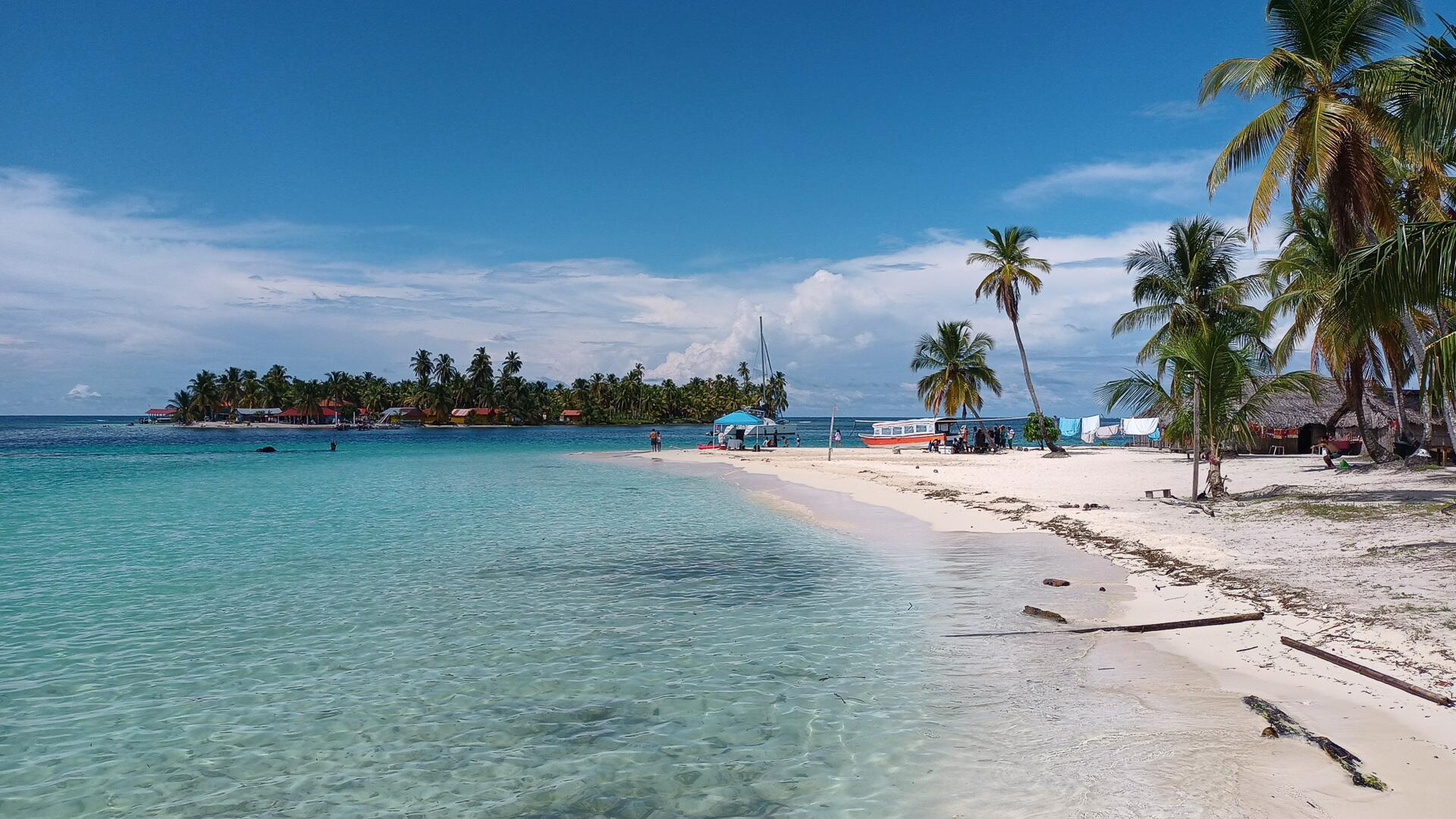
Assudub Bibbi, a holiday destination for wealthy tourists. The Caribbean island is located 14 kilometres northeast of Gardi Sugdub




